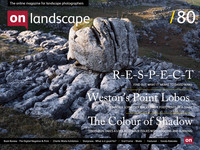David Ward chooses one of his favourite images

David Ward
T-shirt winning landscape photographer, one time carpenter, full-time workshop leader and occasional author who does all his own decorating.
Many of the previous incumbents of this post have remarked upon the impossibility of the task presented to us by our esteemed editor. It might not quite be comparable with the Labours of Hercules but it’s still pretty daunting. When Tim asked me to suggest my End Frame I briefly toyed with saying “No!”... but quickly dismissed this as an option. A few moments thought during the phone call had already provided a long list of possible candidates: Evening’s Edge by Michael Fatali (probably the only image by him that I truly admire); any one of a number of glorious aspen images by Ansel Adams; too many to choose from by Minor White; ditto for Eliot Porter; and what about Michael Kenna’s extensive body of work? I love his Seven Posts image; Pepper #30 by Edward Weston has to be in my top five; as does Joe Cornish’s image of Tràigh Eais on Barra. There might be too many to choose from but it seemed like an interesting challenge.
Time to be logical; what criteria could I use? There are a number of attributes that I really admire in an image; I’m well known for appreciating beauty, mystery and simplicity. I’m also very impressed by images that surprise me, images that I don’t feel I would have made. However, I think the highest value goes to images that taught me something.
Armed with this new selection tool I started, once again, thumbing through my library of photography books. After some considerable dithering, I chose Charlie Waite’s Near Stonhenge, Wiltshire because I think that this famous image of round straw bales not only fulfills most of my criteria and but is very remarkable in many other ways.
It’s no exaggeration to say that Charlie was a huge inspiration to me when I first started to look at landscape photographs in the late 1970’s. So many books published in the UK prior to that era used landscape as illustrations with little artistic merit. If you wanted to see inspiring landscape images you had to turn to the work of the American greats like Ansel Adams. With the notable exception of Eliot Porter, this work was almost all monochrome. Porter used 10x8 negative film to make his complex and intriguing studies of portions of nature. His images had a quiet, contemplative feel that was very different from contemporary commercial colour work that tended to concentrate, as amateur photography does now, on the spectacular.

